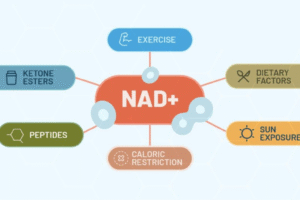Maintaining good oral health is essential for overall well-being. Comprehensive dental services encompass a wide range of treatments and procedures designed to keep your teeth, gums, and mouth healthy. This article explores various dental services, from routine cleanings to advanced procedures, highlighting their importance and benefits.

Routine Dental Care
Regular Dental Check-Ups
Importance of Regular Check-Ups
Regular dental check-ups are crucial for preventing dental problems and maintaining optimal oral health. These visits help detect issues early and provide an opportunity for professional cleaning and assessment.
Benefits:
- Early Detection: Identifies dental issues such as cavities, gum disease, and oral cancer at an early stage.
- Preventive Care: Helps prevent the progression of dental problems.
- Professional Advice: Offers personalized advice on maintaining oral hygiene and addressing specific concerns.
Components of a Dental Check-Up
A typical dental check-up includes a thorough examination of the teeth, gums, and mouth, followed by professional cleaning.
Examination:
- Visual Inspection: Checking for signs of tooth decay, gum disease, and other oral health issues.
- X-Rays: Taking X-rays to identify problems not visible during the visual inspection, such as cavities between teeth or bone loss.
- Oral Cancer Screening: Examining the mouth for any signs of oral cancer.
Cleaning:
- Scaling: Removing plaque and tartar buildup from the teeth surfaces.
- Polishing: Polishing the teeth to remove stains and smooth the surface.
- Fluoride Treatment: Applying fluoride to strengthen the teeth and prevent cavities.
Preventive Dental Care
Dental Sealants
Dental sealants are thin, protective coatings applied to the chewing surfaces of the back teeth (molars) to prevent cavities.
Benefits:
- Protection: Seals grooves and pits where food particles and bacteria can accumulate.
- Durability: Can last several years with proper care.
Fluoride Treatments
Fluoride treatments help strengthen the enamel and make teeth more resistant to decay.
Benefits:
- Strengthening: Reinforces the enamel, reducing the risk of cavities.
- Safety: Safe and effective for children and adults.
Home Oral Hygiene
Brushing and Flossing
Proper brushing and flossing are fundamental to maintaining good oral health.
Brushing Tips:
- Frequency: Brush at least twice a day with fluoride toothpaste.
- Technique: Use a soft-bristled brush and gentle circular motions to clean all surfaces of the teeth.
Flossing Tips:
- Frequency: Floss at least once a day to remove plaque and food particles between teeth.
- Technique: Use a gentle sawing motion and curve the floss around each tooth.
Mouthwash
Using mouthwash can help reduce bacteria, freshen breath, and promote oral health.
Types of Mouthwash:
- Antiseptic Mouthwash: Reduces bacteria and prevents gingivitis.
- Fluoride Mouthwash: Helps prevent tooth decay.
Restorative Dental Services
Fillings and Crowns
Dental Fillings
Fillings are used to repair cavities and restore the function and appearance of the affected teeth.
Materials:
- Amalgam: Durable and suitable for back teeth.
- Composite Resin: Tooth-colored and aesthetically pleasing.
Dental Crowns
Crowns are caps placed over damaged or decayed teeth to restore their shape, size, and strength.
Materials:
- Porcelain: Aesthetic and suitable for front teeth.
- Metal: Durable and suitable for back teeth.
- Porcelain-Fused-to-Metal: Combines aesthetics and durability.
Root Canal Therapy
Understanding Root Canal Therapy
Root canal therapy is a treatment used to save a tooth that is severely decayed or infected.
Procedure:
- Removal: Removing the infected or damaged pulp from the inside of the tooth.
- Cleaning: Cleaning and disinfecting the root canals.
- Filling: Filling the root canals with a biocompatible material.
- Restoration: Placing a crown or filling to restore the tooth.
Benefits:
- Pain Relief: Eliminates pain caused by infection or inflammation.
- Preservation: Saves the natural tooth and prevents the need for extraction.
Dental Implants
Overview of Dental Implants
Dental implants are a permanent solution for replacing missing teeth. They consist of a titanium post surgically placed in the jawbone, which acts as an artificial tooth root.
Procedure:
- Placement: Surgically placing the implant in the jawbone.
- Osseointegration: Allowing the implant to fuse with the bone over several months.
- Restoration: Attaching an abutment and crown to the implant.
Benefits:
- Natural Look and Feel: Mimics the appearance and function of natural teeth.
- Durability: Long-lasting with proper care.
- Preservation: Helps maintain jawbone structure and prevent bone loss.
Cosmetic Dental Services
Teeth Whitening
In-Office Teeth Whitening
Professional teeth whitening performed in a dental office provides fast and effective results.
Procedure:
- Application: Applying a high-concentration bleaching gel to the teeth.
- Activation: Using a special light to enhance the whitening process.
Benefits:
- Quick Results: Noticeable results in a single visit.
- Effectiveness: More effective than over-the-counter products.
At-Home Teeth Whitening
Dentists can provide custom-fitted trays and professional-grade whitening gel for at-home use.
Procedure:
- Custom Trays: Creating custom-fitted trays for the patient.
- Application: Filling the trays with whitening gel and wearing them for a specified duration.
Benefits:
- Convenience: Can be done at home at the patient’s convenience.
- Gradual Results: Allows for gradual whitening over a few weeks.
Veneers
Understanding Veneers
Veneers are thin shells of porcelain or composite resin that are bonded to the front surfaces of the teeth to improve their appearance.
Procedure:
- Preparation: Removing a small amount of enamel from the tooth surface.
- Impression: Taking an impression of the teeth to create custom veneers.
- Bonding: Bonding the veneers to the teeth.
Benefits:
- Aesthetic Improvement: Enhances the appearance of stained, chipped, or misaligned teeth.
- Durability: Long-lasting with proper care.
Orthodontics
Traditional Braces
Traditional braces use metal brackets and wires to gradually move teeth into the desired position.
Procedure:
- Bonding: Attaching metal brackets to the teeth.
- Adjustment: Periodically adjusting the wires to guide teeth movement.
Benefits:
- Effectiveness: Effective for correcting various orthodontic issues, including crowding, gaps, and bite problems.
Clear Aligners
Clear aligners, such as Invisalign, are a discreet alternative to traditional braces.
Procedure:
- Custom Trays: Creating a series of custom-fitted aligner trays.
- Progression: Wearing each set of aligners for a specified period before moving to the next set.
Benefits:
- Aesthetics: Nearly invisible, providing a discreet option.
- Convenience: Removable for eating, brushing, and flossing.
Advanced Dental Procedures
Periodontal Treatment
Gum Disease Treatment
Periodontal treatment addresses gum disease, which can lead to tooth loss if left untreated.
Procedures:
- Scaling and Root Planing: Deep cleaning to remove plaque and tartar from below the gumline.
- Periodontal Surgery: Surgical procedures to treat advanced gum disease.
Benefits:
- Prevention: Prevents progression of gum disease and preserves natural teeth.
- Health Improvement: Reduces inflammation and improves overall oral health.
Oral Surgery
Tooth Extractions
Tooth extractions are performed when a tooth is severely damaged or decayed and cannot be saved.
Procedure:
- Simple Extraction: Removing a visible tooth.
- Surgical Extraction: Removing a tooth that is broken or impacted, often involving an incision.
Benefits:
- Pain Relief: Eliminates pain caused by a damaged or infected tooth.
- Preparation for Implants or Braces: Creates space for dental implants or orthodontic treatment.
Wisdom Teeth Removal
Wisdom teeth removal is a common oral surgery procedure to prevent or address problems caused by impacted or misaligned wisdom teeth.
Procedure:
- Extraction: Removing one or more wisdom teeth, often under local or general anesthesia.
Benefits:
- Prevention: Prevents overcrowding, infections, and damage to adjacent teeth.
- Recovery: Typically involves a short recovery period with proper care.
Sedation Dentistry
Understanding Sedation Dentistry
Sedation dentistry uses medication to help patients relax during dental procedures.
Types of Sedation:
- Nitrous Oxide: Also known as laughing gas, provides mild sedation and relaxation.
- Oral Sedation: Taking a sedative pill before the procedure for moderate sedation.
- IV Sedation: Administering sedatives intravenously for deeper sedation.
- General Anesthesia: Inducing unconsciousness for complex or lengthy procedures.
Benefits:
- Anxiety Relief: Helps patients with dental anxiety or phobia.
- Comfort: Enhances comfort during procedures, especially for lengthy or invasive treatments.
Comprehensive dental services encompass a wide range of treatments and procedures designed to maintain and improve oral health. From routine cleanings and preventive care to advanced restorative and cosmetic treatments, these services are essential for preserving the health and appearance of your teeth and gums. Regular dental visits, proper home oral hygiene, and timely intervention for dental issues can ensure a lifetime of healthy smiles. By understanding the various dental services available, you can make informed decisions about your oral health and seek the appropriate care to meet your needs.














